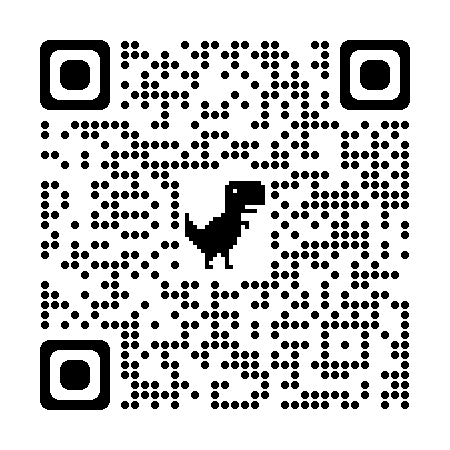On the anniversary of his martyrdom. Who is Kamal Adwan?
His first name is Ahmed Kamal, He is nicknamed Abu Rami, a native of the village of Berbera, south of Al-Majdal (Ashkelon), famous for its distinguished grapes, He was born in 1935 as the third of his brothers: Suad and Mohamed Ali, His father was a contractor and a Berber notable. The family took refuge in the Gaza Strip during the 1948 war and lived in Rafah for six months, then his father preferred to live in Gaza. He died there in 1952 and his older brother, Muhammad Ali, helped him complete his high school and university studies.
Kamal studied primary school at Berbera School and in Gaza he completed his preparatory studies at the Remal Preparatory School of the United Nations Relief and Works Agency for Palestine Refugees in the Near East (UNRWA). Then he moved to Imam Shafi’i Secondary School, during which he joined the Muslim Brotherhood in 1952 influenced by the heroism of the Muslim Brotherhood in the 1948 war and its guerrilla actions after it. Desiring to liberate Palestine and to take every path leading to this goal, His classmates at school and the group were: Ghalib al-Wazir, Khalil al-Wazir and Riad al-Za’noun.
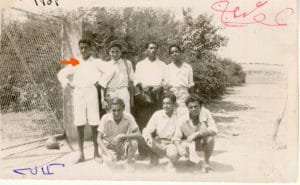
Then he completed his studies at the Palestine Secondary School, during which he was acquainted with the partisan rivalry over the Palestinian Students Association in Cairo and the start of directing the Muslim Brotherhood its first interest against Abdel Nasser after he struck the group in Egypt in early 1954 and made the Palestinian issue in the second place of its attention. Therefore, he turned to national action, He wrote a project to organize a national movement in Gaza and sent it with one of his friends to Cairo to show it to his colleagues in the student association, but the project was seized and Kamal was arrested for a few days ([1]), then subjected to the surveillance and prosecution of Egyptian intelligence([2]).
Kamal joined Cairo University in 1954 where he entered the Faculty of Engineering majoring in Petroleum and Minerals ([3]), and in the same year he got to know the Egyptian intelligence officer Al-Youzbashi Mustafa Hafez by Mustafa Hafez’s brother (*) who was a colleague of Kamal in the faculty. He benefited from his military experience, providing him with military books and maps and accompanying him on reconnaissance operations inside the occupied territories. Hence the idea of guerrilla armed action and its importance in destabilizing the stability and security of Israel arose in Kamal’s mind. He formed a group of his brothers from the Muslim Brotherhood to carry out workers inside the occupied territories[4], including: Khalil al-Wazir, Hamad al-Aydi and Abdullah Siyam[5].

He called for the first meeting to establish a broad Palestinian formation aimed at liberating Palestine and taking the initiative in Palestinian action from the hands of Arab governments and parties. It was attended by 12 young people, all of them from the Muslim Brotherhood, who decided to call for their idea within the various parties for five years, after which they met to draw up the charter of his movement, Their guerrilla operations were launched after this meeting[6].
The most important of which was the bombing of the Zohar Dam in early 1955, with the participation of Khalil Al-Wazir and Hamad Al-Aydi, Kamal was prevented from traveling until the Israeli raid on Gaza on 28/2/1955, after which demonstrations began roaming the streets of the Gaza Strip demanding recruitment and armament, in which Kamal participated. In the midst of the authorities’ preoccupation with these demonstrations, he left Gaza for Egypt on 3/3/1955 and then to Qatar[7]), where he worked as a teacher for one year in 1955.
Kamal participated in the first preparatory conference for the founders of Fatah in March 1956 in Cairo, and it was decided to postpone the announcement of the organization until the next year, during which he contracted with Saudi Arabia to work there with other activists. When President Abdel Nasser announced the nationalization of the Suez Canal, he distributed jointly with others a statement warning the West of the consequences of aggression against Egypt, threatening to blow up oil wells supervised by Aramco, which led to the expulsion of a thousand Palestinian workers who worked for the company in Dammam and Dhahran[8]).
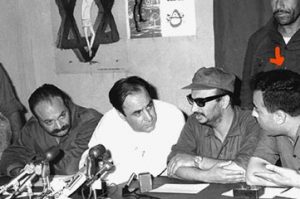
On 28/10/1956, Kamal returned to Gaza and with the Israeli occupation control of the Gaza Strip, he took over the leadership of the Muslim Brotherhood in the Gaza Strip with the aim of forming a popular resistance and began to contact the youth of the Arab Socialist Baath Party and the Arab Nationalist Movement and the young independents who withdrew from the Muslim Brotherhood previously and was one of those who negotiated with the communists and following the issuance of some of their publications and arrest, They confessed in the investigation to Kamal’s role in the popular resistance, so he fled to Egypt and took Al-Arish as an external headquarters to support the popular resistance until the exit of the Israeli occupation on 7/3/1957 ([9]).
After the return of the Egyptian administration on 14/3/1957, the nucleus of Fatah met in a second preparatory conference in Gaza(
[10]
)In the same year, Kamal went to Qatar to work in teaching and got to know Mahmoud Abbas, Abdullah Al-Danan and Muhammad Yusuf Al-Najjar, and there he wrote the story of his struggle for the period from 1954-1957.(
[11]
), which he called “terrorism beyond borders” and in which he was careful not to mention names explicitly most of the time for fear that the manuscript would fall into the hands of the movement’s enemies.
He worked as a trainee engineer in the petroleum field with Aramco in Dammam in 1958, during which time he participated in the drafting of the Fatah Charter in September 1958 with Abdel Fattah Hammoud, Saeed Al-Mishal, Yasser Arafat, Khalil Al-Wazir and Adel Yassin.([12]).
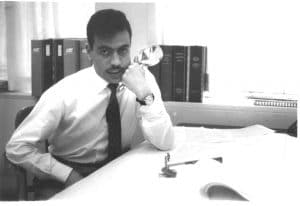
Because he had interrupted his studies for professional and political work, he graduated from university in 1961. He then worked in Saudi Arabia and then moved as a petroleum engineer in Qatar in 1963. He participated in the Palestinian National Council since its first session in Jerusalem on 28/5-2/6/1964. Since 1958, he has predicted that the Palestinian revolution will be launched and its own radio station[13].
In September 1968, he left his job in Qatar and devoted himself to work in the Fatah movement in charge of the media, based in Amman, and was able to establish an advanced media apparatus with his newspaper and relations at the Arab and international media levels. He participated in the events of September 1970 and then moved to Jerash and Dibbin. Then to Damascus and Beirut, where he worked on the reconstruction of Fatah’s media apparatus[1] and co-founded the Palestinian news agency Wafa[2].
Follow an article on the anniversary of his martyrdom. Who is Kamal Adwan?
He was elected a member of Fatah’s Central Committee at the movement’s third congress in September 1971 and was entrusted with responsibility for the occupied territory sector (the western sector) and supervising the struggle and military action at home. This may have been a major reason for the enemy’s eagerness to get rid of him.[3]

He was then elected as a member of the Preparatory Committee for the selection of members of the Palestinian People’s Congress held in Cairo in March 1972.
He was martyred on 10/4/1973 in his apartment on Verdun Street in Beirut. Where an Israeli squad went to kill Kamal Adwan,Kamal Nasser andMuhammad Yusuf al-Najjar, Kamal fought his attackers until the last bullet and was able to eliminate a number of them before his martyrdom ([4]), and from the hatred of the Israeli enemy on him they fired a hundred bullets at his body ([5]), leaving behind his wife and two sons Dana and Rami.
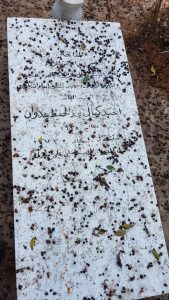
He was very self-aggressive, but only the narrow group he worked with felt it. violently in defending his opinion as long as he believes in it until they convince him of their point of view, Silent and does not participate in public conversations except with short comments, but within his organization he is a revolutionary discussant who analyzes when he feels the positive discussion, He has a chest capacity in dealing with the youth of other parties, as he is not a fanatic of his own party ([6]).

Follow an article on the anniversary of his martyrdom. Who is Kamal Adwan?
Selections from the sayings of the martyr:
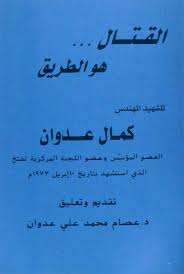
A country that lives a life of struggle. Driven by the will to fight. He must rearrange things in the authority, the plan and the tools that will be based on this plan in a way that ensures harmony with the will to fight. and the fighting life he lives so that he can practice his struggle. It achieves its editorial goals. ([1])
We want to build a country that fights, everything that has a fighter, a fighter with its people, a fighter with its army, a fighter with its economy, a fighter with its media. A country that lives a life of fighting until it is able to liquidate the occupation. We must first and clearly agree: do we really want to fight? Do we really want to win?… If we all agree on this, then things need to be rearranged in this way and in this direction, and then there will be no problem and we will all be one people in one row without caution. Fearlessly.. One row is capable of crushing every adventurer or conspirator who wants to disrupt the struggle of our people from any side. From any party, then there will be no parties, we will be one party, leading the country to its goals of liberation. ([2])
Under the banner of fighting. The agent turns into a patriot. In the name of fighting, we halve the will to confront and confront. Under the name of fighting, settlement arrangements are made. and settlement settlement. and concessions. ([3])
The official Arab mind has a drug, controlled by the will of helplessness and surrender, waiting for American sympathy. To wake up, recalculate logically and reasonably, reaffirm its basic concepts and issues, and prioritize it. In this regard, it must be clear: First: The liquidation of the occupation cannot be by understanding with it. Second, the trend towards compromise is a blind disregard for the reality of the philosophy of the Israeli presence and its ambition in the region, and the danger it poses to national security and the future of the Arab presence. Third, any genuine will to fight has alliances and characteristics of a nature compatible with this will to fight. All arrangements must be subject to the calculation of this will. Fourth: Armed struggle is the true expression of the will to fight and is the only entrance to mobilizing the will of the nation, organizing it and achieving its unity.([4]).
Those who proceed from the hypothesis of compromise as a possible, serious and recognized truth. They arrange their situation on the basis of this premise, they have no choice but to bargain, and the issue remains how much they can get the American sympathy that governs the region and makes a settlement. They have no choice but to kneel for an understanding with the occupation. And those who start from another completely opposite hypothesis, which says to prevent settlement and confront the occupation. These have nothing to do with the international balance of power. Their only relationship with the local capacity of action that they themselves can create by mobilizing the mass will to fight in their people. Let this will turn into a real actor. This ability may be limited now, but it certainly cannot be controlled, restricted, or ignored its will, and it is poised to grow, develop, and increase, and its action and ability to govern or participate in the event increases. And she no longer needs someone to sympathize with her…. But it needs to be understood([5]).
The continuation of the revolution means no compromise. Passing a compromise means liquidating the revolution. Therefore, we are faced with duties: That the revolution continues so that the settlement does not pass. In order for the revolution to continue, conditions are required. As for the conditions for the continuation of any national revolution, they are twofold: (1) The existence of an occupation faced by resistance that pushes the masses to adopt a program of revolution. (2) The establishment of a national authority that adopts the program of the revolution; and push its masses to adopt the program of the revolution, It bears responsibility for the consequences of this adoption.[6]
([1])Kamal Adwan, Fatah al-Milad wal-Masirah (Beirut: MTF Unified Media, 1974), p. 64.
[3] Ibid., p. 100. He spoke about the rush of Arab regimes for peace at the expense of the Palestinian people. And under the cloak of mobilization and readiness to fight the enemy.
[6] Ibid., pp. 147-148. He had estimated that the candidate place for the establishment of the PNA was Jordan.
([2]) Mohammed Hamza, Abu Jihad, p. 252.
([3]) The Palestinian Encyclopedia, Q1, C3, p. 661, Hassan Khalil Hussein, with the immortals, April 1996, pp. 120-1.
([4]) Fatah Bulletin, Number 15, p. 8.
([6]) aggression, Terrorism beyond borders, pp. 55-56.
[1] See about his arrest: Aggression Terrorism beyond borders, P56.
([2]) Salim al-Za’noun, Personal interview, In Amman on 8/12/1997.
([3]) Palestinian Encyclopedia Authority, The Palestinian Encyclopedia-Part One, (Beirut: Palestinian Encyclopedia, 1982, Volume 3, p. 661 (Article K- Kamal Adwan).
Kamal Adwan deliberately mentioned him in the book (Terrorism Beyond the Borders), Bassem Al-Youzbashi Mustafa Abdul Rahim.
([4]) aggression, Terrorism beyond borders, pp. 60-61.
([5]) Minister, Fatah Beginnings, pp. 17-18.
([6]) aggression, Terrorism beyond borders, pp. 60-61.
([7]) aggression, Terrorism beyond borders, P22.
([9]) Palestine Liberation Organization, “First Anniversary of the Three Martyrs”, Palestine Revolution, (Beirut: Central Newspaper of the PLO, No. 87, 10/4/1974), P9.
([10]) aggression, Terrorism beyond borders, p. 243.
([11]) Ghalib al-Wazir, Personal interview, in Gaza on 27/11/1998.







